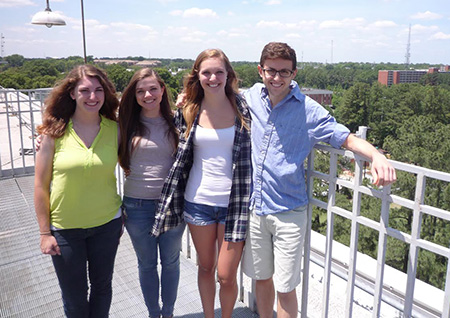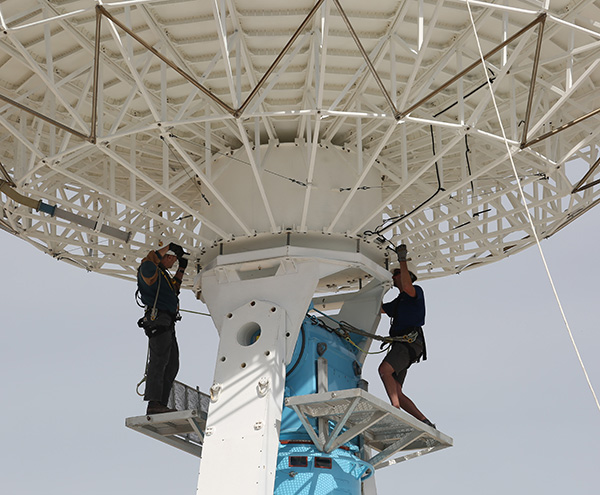Students run radar from afar
North Carolina State puts NCAR’s S-Pol through its paces
Jun 18, 2014 - by Staff
Jun 18, 2014 - by Staff
June 18, 2014 | You can now use software to turn on your car before you leave the office or turn on the lights before you get home. What about operating a sophisticated radar remotely? Students at North Carolina State University are doing just that, learning about severe storm structure and radar operations at the same time.
In a first for NCAR, the center’s Colorado-based S-Pol research radar is being operated from 1,600 miles away. Over the last month, four undergraduate NCSU students in Raleigh, North Carolina, have been controlling S-Pol, stationed near the town of Firestone, as well as Colorado State University’s CSU-CHILL radar, located near Greeley. The operations are designed to collect data for a set of NSF-funded education modules led by NCSU atmospheric science professor Sandra Yuter.

These undergraduates from North Carolina State University’s Department of Marine, Earth, and Atmospheric Sciences got a unique opportunity this spring to operate NCAR’s S-Pol research radar from a distance. Left to right, atop the department building: Sara Berry, Nicole Corbin, Megan Amanatides, and Jason Endries. (Photo courtesy Sandra Yuter.)
“I like making my own forecasts and seeing them unfold on the radars in real time,” said NCSU’s Nicole Corbin. “It’s especially neat that we can see the 3-D structure of the storms as they evolve.”
Another participant, Sara Berry, pointed out the value of student-directed educational opportunities: “Controlling the radars has given me a more active involvement with the weather. I can choose what I want to scan and study.” Thanks to the project, she added, “I am much more aware of the weather in Colorado than in my own state!”
Late May and early June is prime time for severe weather in northeast Colorado, and that climatology held true this year, with hail- and tornado-producing thunderstorms dotting the plains on numerous days.
“We are obtaining a fantastic radar data set for the education modules,” said Yuter. “In particular, the vertical slices scanned by the S-Pol and CHILL radars are providing incredible detail on the air flows through the storms.”
Although S-Pol is a much larger radar than the kind of portable Doppler units famed for their use in storm chasing, NCAR's engineers devised a system using eight cargo containers to transport and then deploy S-Pol at field projects around the globe. Before this summer, though, the radar had never been remotely operated from a great distance, said NCAR associate scientist Scott Ellis.
Since the 28-foot-diameter transmitting/receiving dish was already being steered from computer terminals on site, it might have seemed straightforward to set up the operations from North Carolina. However, there were numerous technical challenges that had to be overcome.
One critical component needed for remote operation of S-Pol was a way to monitor system status and notify staff of any issues. According to Ellis, the radar now monitors all of its subsystems and automatically sends a message to a designated phone if it finds any problems. A webcam keeps an eye on the antenna as it scans. And the radar subsystems have been re-engineered so that many issues can now be resolved remotely, relieving the need for staff to be located at the radar during operations.
“Making S-Pol remotely operable—from warming up the transmitter, through adjusting the scans, displaying the data in real time, and then shutting down—really adds to the utility of the radar,” said Ellis. “This opens up a big opportunity to expand our user base and to make smaller projects more accessible to researchers. We’re really excited about that.”
Ellis hopes that other universities will take advantage of S-Pol’s remote capabilities. He noted that a newly streamlined process allows smaller research and education projects to be carried out without the more involved approvals required for major field campaigns funded by the National Science Foundation (see website for details).
|
Writer/contact Researchers |
Funders |

Technicians install the transmitter dish for NCAR’s S-Pol radar during a move to its permanent location near Firestone, Colorado, in October 2013. Using dual-polarization techniques pioneered at NCAR and NOAA, S-Pol can distinguish raindrops from hailstones, a crucial difference in evaluating the potential for torrential rain. The National Weather Service recently added dual-polarization capability to its national NEXRAD network of Doppler radars (Photo by Carlye Calvin, © UCAR.)